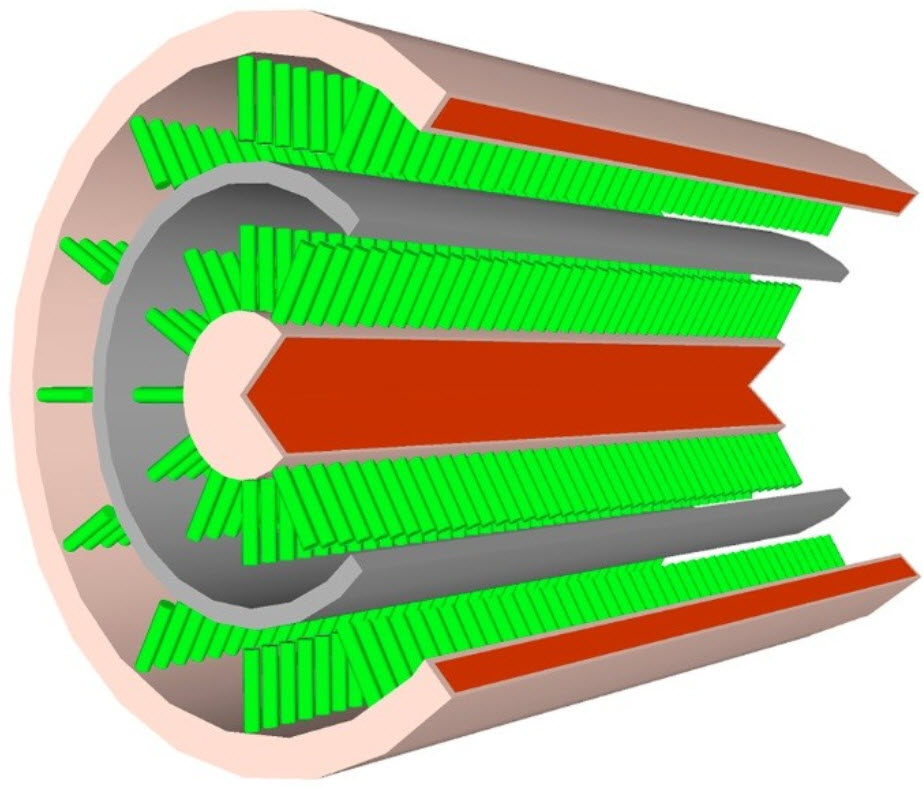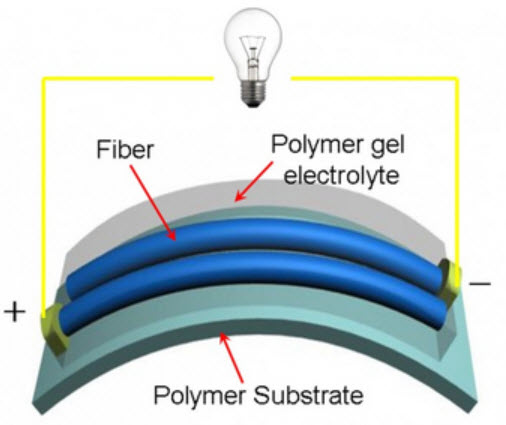Wires that can store energy like batteries
June 6, 2014

Copper wire surrounded by two supercapacitor layers created by special nanowhiskers (green) (credit: UCF)
University of Central Florida researchers have invented a way to store energy in a copper wire by wrapping a supercapacitor* sheath around a core conductor wire, acting as a battery to power a connected device.
Applications could include electrical vehicles, space-launch vehicles, and portable electronic devices. By being able to store and conduct energy on the same wire, heavy, space-consuming batteries could become a thing of the past, allowing for greater miniaturization of electronic devices.
Nanotechnology researcher and professor Jayan Thomas said copper wire is the starting point, but eventually, as the technology improves, special fibers could also be developed with nanostructures to conduct and store energy.
The design
Thomas and his team began with a single copper wire. Then he placed a sheath over the wire made up of nanowhiskers that the team grew on the outer surface of the copper wire. These whiskers were then treated with a special alloy, which created an electrode.
Two electrodes are needed for capacitors. So they added a thin plastic sheet around the whiskers and wrapped it around using a metal sheath after generating nanowhiskers on the second electrode and outer covering. The layers were then glued together with a special gel. Because of the insulation, the inner copper wire retains its ability to conduct electrical energy, but the layers around the wire independently store energy.
Although more work needs to be done, Thomas said the technique should be transferable to other types of materials, such as clothing fibers. For example, flexible solar cells and these fibers could be wired into a jacket to power electronic gadgets and other devices.
Their work is the focus of the cover story of the June 30 issue of the material science journal Advanced Materials and science magazine Nature.
The Nature article points out that the design is limited to DC, which could allow for powering small electronic devices, humanoid robots, and automotive electronics, all of which use direct current, but not household or industrial uses, which require AC. “The devices might also be useful for storing the electrical energy produced by solar panels or wind-power generators,” the article says, thus leveling off power in cloudy conditions, for example.
“However, the adoption of energy-storing cables as replacements for stand-alone supercapacitors or batteries will depend on whether low-cost materials such as carbon can be used, and on the development of simple manufacturing processes,” the article noted.
Supercapacitor-based fibers with high storage capacity
Nanyang Technological University (NTU) in Singapore, Tsinghua University in China, and Case Western Reserve University have also recently developed another supercapacitor design that packs an interconnected network of graphene and carbon nanotubes so tightly that it stores energy comparable to some thin-film lithium batteries.
They believe the storage capacity by volume (called volumetric energy density) is the highest reported for carbon-based microscale supercapacitors to date: 6.3 microwatt hours per cubic millimeter.
The researchers have also developed a way to incorporate the supercapacitor in a flexible fiber. To date, they’ve made 50-meter long fibers.
They envision the fiber supercapacitor could be woven into clothing to power medical devices for people at home, or communications devices for soldiers in the field. Or, they say, the fiber could be a space-saving power source and serve as “energy-carrying wires” in medical implants.
The scientists report their research in Nature Nanotechnology.
The Ministry of Education, Singapore and the Asian Office of Aerospace Research and Development of the U.S. Air Force, and the U.S. Air Force Office of Scientific Research funded the research.
* Supercapacitors have high power density, meaning they can quickly store (and discharge) powerful amounts of energy, like that needed to start a vehicle, and also have high energy density compared to conventional capacitors, meaning that can store high amounts of energy in a given volume (but less than conventional batteries). (See Graphene micro-supercapacitors to replace batteries for microelectonics devices.)
Abstract of Advanced Materials paper
A novel device architecture of a coaxial supercapacitor cable that functions both as electrical cable and energy storage device is demonstrated. The inner core is used for electrical conduction and the overlying layers are used for energy storage. This unique design provides excellent flexibility, long and stable cycle lifetimes, and high energy and power densities. All these remarkable results demonstrate a clear technological advance achieved by clubbing electrical conduction and energy storage into a single cable.
